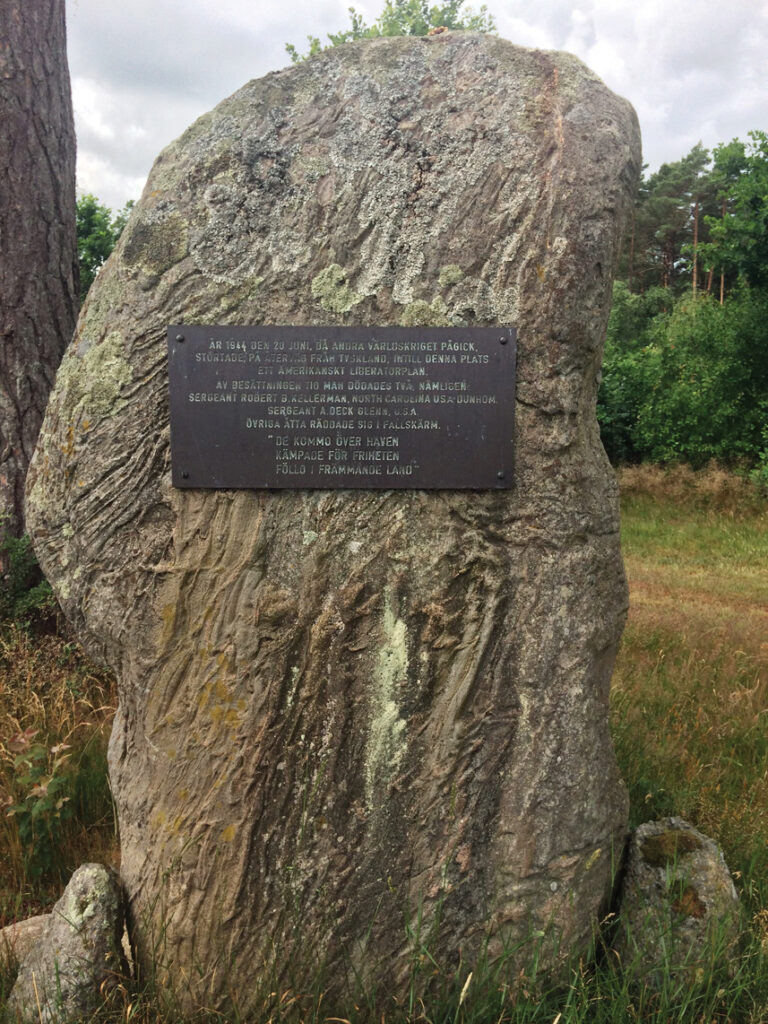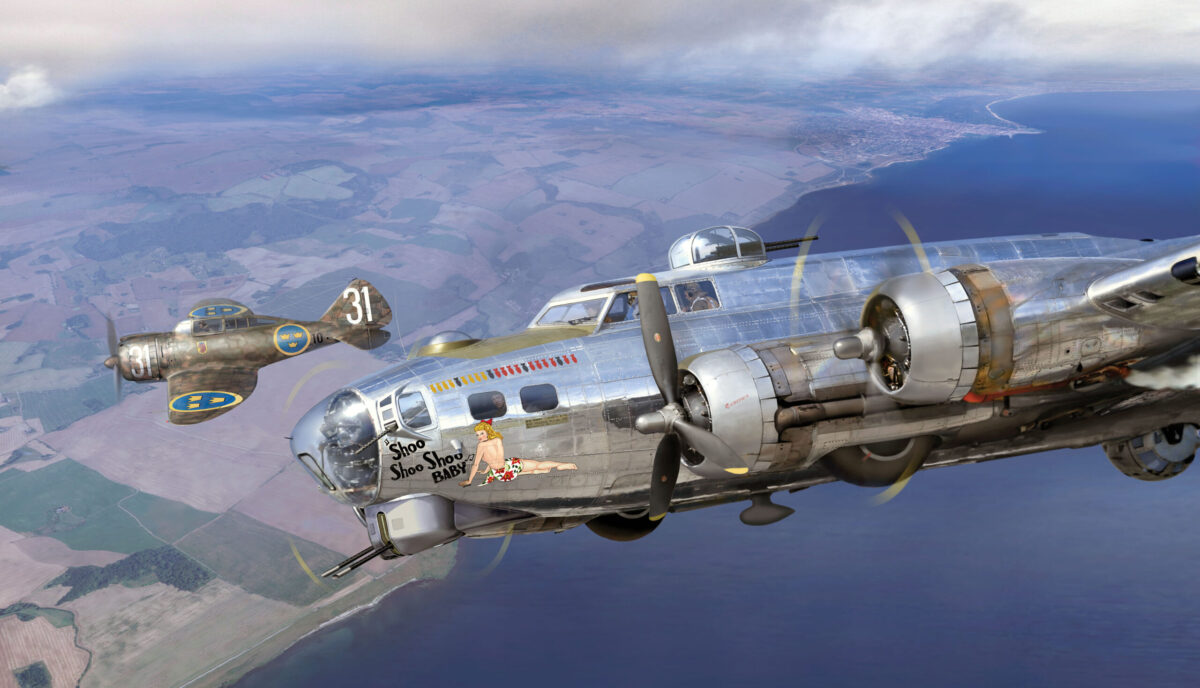Osce V. Jones, a 26-year-old first lieutenant in the U.S. Army Air Forces, was a war-tested pilot by the summer of 1943. Born in the small Georgia town of Camilla on August 6, 1916, Jones attended Louisiana State University and enlisted in the U.S. Army National Guard in the fall of 1940. He entered flight school a few months later, graduating in early December 1942, and was assigned as the pilot of a Boeing B-17 Flying Fortress. The next May he and his crew flew their airplane from Dow Army Airfield in Maine to RAF Ridgewell airfield in southeastern England, the eventual home of the Eighth Air Force’s 381st Bombardment Group. After they arrived, the crew named their bomber, tail number 42-3217, Georgia Rebel.
Jones had completed five missions over Europe, but his luck ran out on July 24, 1943. On that day, Georgia Rebel was one of the 324 bombers that Brig. Gen. Ira C. Eaker, commanding general of the U.S. Eighth Air Force, sent out on what was the Eighth’s first operation against targets in Nazi-occupied Norway. Georgia Rebel’s target was an aluminum, nitrate and magnesium manufacturing complex at Herøya, just south of Oslo.
After releasing its bombs, the aircraft was hit by a barrage of antiaircraft fire at 2:18 p.m. and was last seen by its group as it left the formation. One engine was smoking, another was out of commission, and fuel was leaking through a hole in the port wing. Jones and his navigator, 2nd Lt. Arthur L. Guertin, agreed that a safe return to England was unlikely, so the young pilot swung the crippled aircraft northeast from Herøya toward neutral Sweden. Once over the Swedish town of Årjäng, Jones turned north and flew low over rolling, wooded hills for about 15 miles until he saw a long, open field just south of the village of Vännacka. Local residents looked up as the plane passed over the field and circled back to make a perfect belly-landing.
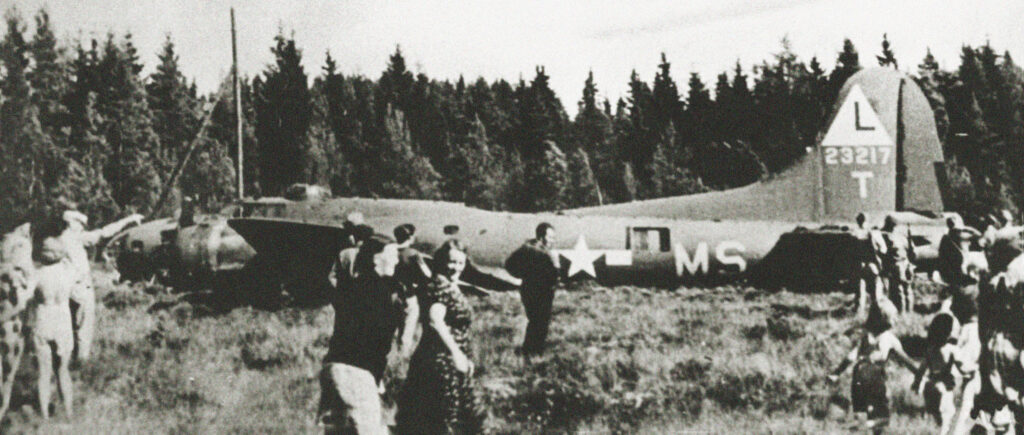
Among the first to reach the plane was farmer Olof Persson. “I understood immediately that it was a British or American bomber because it said ‘Georgia Rebel’ on the fuselage, and I saw a five-pointed star and the colors of the flag,” Persson told a reporter from the Swedish newspaper, Aftonbladet. “So I hurried to the bog where the plane had crashed.” Persson greeted the pilot in English. “Well, how do you do?” he said.
By the time Persson reached the B-17, the Swedish military had also arrived and began to surround the wreck. “I asked the pilot if anybody had been injured,” Persson recalled. “[The pilot] said that he and his nine buddies were [safe and] happy to have landed in Sweden…and he asked me to tell the Swedish military that they had machine guns on board and that they were all loaded, but there were no bombs. They had been released over Norway.”
Jones and his men were the first American aircrew to land in Sweden during the war. They were not the last.
As a neutral country, Sweden was required by the Hague Convention of 1907 to intern any military personnel from belligerent nations who arrived within its borders. Sweden ended up accommodating many Americans. By war’s end, more than 150 crippled American warplanes followed the Georgia Rebel to land or crash land in Sweden, leading to the internment of 1,218 airmen, including Jones and his crew. The vast majority of the internees reached Sweden during a hectic 48-hour period in mid-June 1944 when no fewer than 34 B-17s and B-24 Liberators landed safely or crashed on Swedish soil. A Swedish newspaper, Trelleborgs Allehanda, reported that on June 20—after the Eighth Air Force had deployed 1,965 “heavies” across Europe in one of the largest such operations to date—there was “literally a queue” of American bombers waiting to land at Bulltofta airfield in Malmö. A total of 21 bombers made forced landings in Sweden that day, by far the largest single-day influx of American aircraft in the country since the beginning of the war.
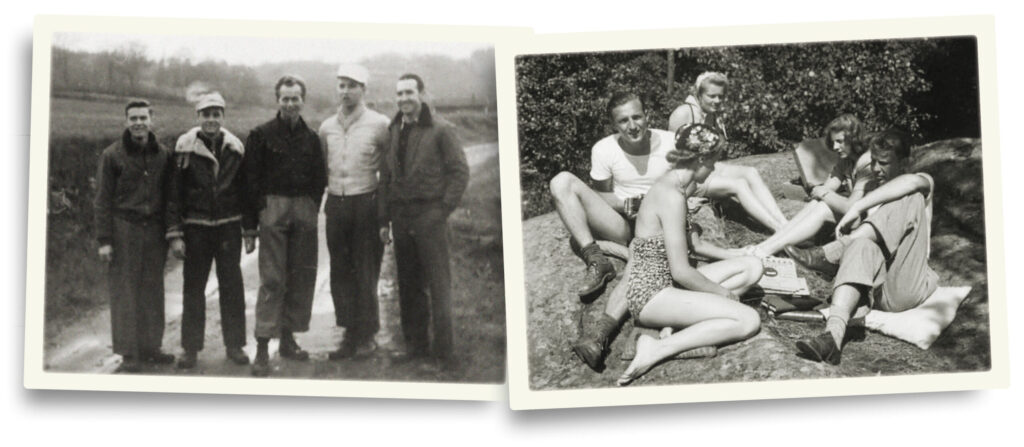
After the planes were on the ground at Bulltofta, according to Trelleborgs Allehanda,“it was hard to find an empty spot” at the airfield. “What’s going to happen during the next few days if a similar invasion continues?” the paper asked. But the invasion continued the next day, June 21, with another 13 American bombers arriving.
One American airplane to reach Sweden that June was a Consolidated B-24 Liberator with the tail number 42-51125 piloted by 1st Lt. Leander Page Jr. Page had been interned in Sweden once before, after his B-24 Queen of Peace had landed there on January 4, 1944. Page was released and he returned to combat, and his plane was hit by flak over Pölitz, Germany, on June 20, damaging the right stabilizer, the rear bomb bay, the fuselage and the two engines on the right wing. “After being hit…the ship dived straight down,” a U.S. intelligence officer later reported after interviewing the copilot, 2nd Lt. F. Leroy Qualey. “The manual controls were found to be inoperative, so the pilot turned the auto-pilot on. The plane went on its back, then recovered. They flew for about twenty minutes more, and No. 2 engine failed. A few minutes later the auto-pilot ceased to work, and they went into a tight spin. The order for bail-out was given.” By this time the airplane was over Swedish territory. Qualey said that after bailing out he landed on a greenhouse and sustained cuts and bruises, while pilot Page hit the side of the bomb bay as he bailed out but suffered only minor injuries.
The unmanned airplane crash-landed in a field near the village of Röstånga and burned for some time. Eight of the 10 crew members were safe, although shaken and slightly injured. The body of Tech Sgt. Robert B. Kellerman, the engineer, was found some distance from the aircraft. According to reports, the body of the tail gunner, Sergeant Glenn A. Deck, was found either in the wreck or nearby. Page said later that both men had been “paralyzed with fear.” Another survivor said that Kellerman may have bailed out too late for his parachute to open fully and that Deck was too frightened to bail out and may have waited too long to make the attempt, or he may have been prevented from exciting by the overwhelming centrifugal force. Page said that his own escape from the aircraft had been due to “great luck,” explaining that he had been literally thrown from the plane when it inverted and went into a spin. Page became the only American airman to be interned in Sweden twice.

After landing, the surviving members of the crew were taken to a local inn and served a hot meal before being sent the next day to an internment camp at Fornäs, near Falun. On July 3, the remains of Kellerman and Deck were interred at a cemetery in Malmö. Copilot Qualey attended the funeral on behalf of the surviving members of the crew, along with representatives of the Swedish government, the U.S. Army and the U.S. Army Air Forces.
Some of the airplanes heading for Sweden never made it. On May 24, 1944, a B-17 with the tail number 42-107178 plunged into the sea off the southern coast of Sweden following a bombing raid on Berlin. According to the ball turret gunner, Tech Sgt. Leonard A. Bielawski, the airplane’s pilot, 1st Lt. William F. Nee, along with two other crew members, 2nd Lt. Reginald Aragona, the copilot, and Tech Sgt. Gaetano A. Scida, the top turret gunner, bailed out after the plane was hit by enemy aircraft fire or flak over Berlin. Apparently, the other members of the crew did not hear the order to exit the plane because the wiring on the back of the pilot’s seat had caught fire, cutting off inter-aircraft communications.
Frederic T. Neel, the 2nd lieutenant who was serving as navigator, managed to extinguish the fire and jumped into the pilot’s seat, telling Tech Sgt. Donald E. Spaulding, the tail gunner, to fly as copilot. Close to the Swedish coast near the village of Örnahusen, the rest of the crew, except for Neel, bailed out. Sgt. Robert Heimbach, the waist gunner, went out first and drowned. Spaulding was killed when he hit the water. Bielawski and Tech Sgt. Philip J. Branner, the radio operator, both landed uninjured. The bombardier, 2nd Lt. Richard Markley, landed in the water and was rescued by Swedish fishermen. As for Neel, he “went down with the ship,” according to Bielawski, who spoke with investigators after the incident. On July 1, several months later, Neel’s body was recovered near the coastal village of Gislöv, about three miles from where the plane had crashed.
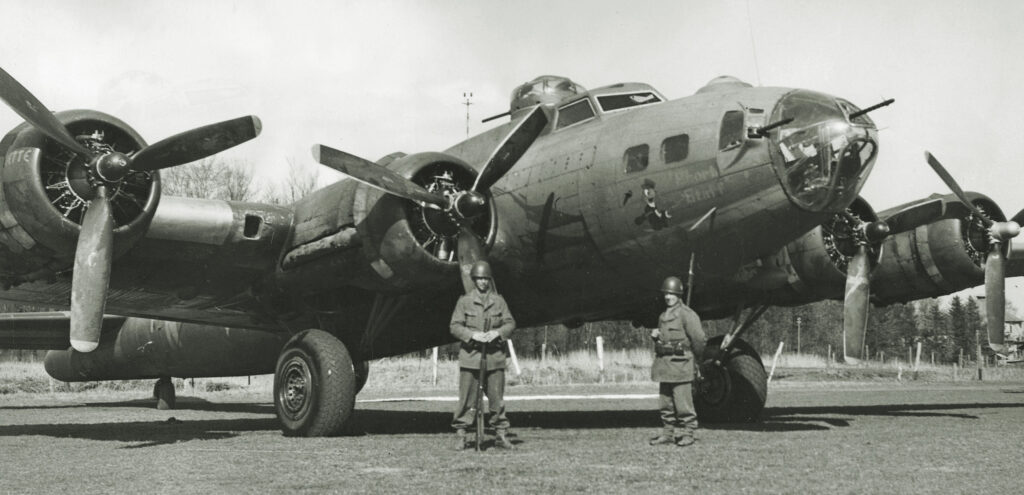
The survivors of Nee’s B-17 joined the growing population of internees in Sweden. The numbers continued to rise, particularly in the first six months of 1944, until there were about 900 by the end of June. As the numbers swelled, so did concerns that some the airmen had diverted to Sweden simply to avoid further combat. In May 1944 The New York Times wrote that the interned airmen were being held in “one of Sweden’s most picturesque regions”—the province of Dalecarlia—and that they were playing “all sorts of games,” reading and enjoying “great freedom of movement.” In August, a multi-page photo essay in Collier’s magazine showed U.S. airmen in tuxedos laughing and drinking at a Stockholm restaurant surrounded by beautiful Swedish women. Others were photographed skiing, riding bicycles and enjoying a dip in a heated indoor swimming pool.
General Henry H. Arnold, commander of the U.S. Army Air Forces, was not pleased by the coverage and he ordered an investigation. He even sent an uncommonly unfriendly memo to his long-time friend, Brig. Gen. Carl A. Spaatz, commander of the newly formed U.S. Strategic Air Forces in Europe (USSTAF), noting that an increasing number of aircraft were landing in neutral countries, like Sweden and Switzerland, “without indication of serious battle damage or mechanical failure, or shortage of fuel.” He wondered whether the landings were “intentional evasions of further combat service.”
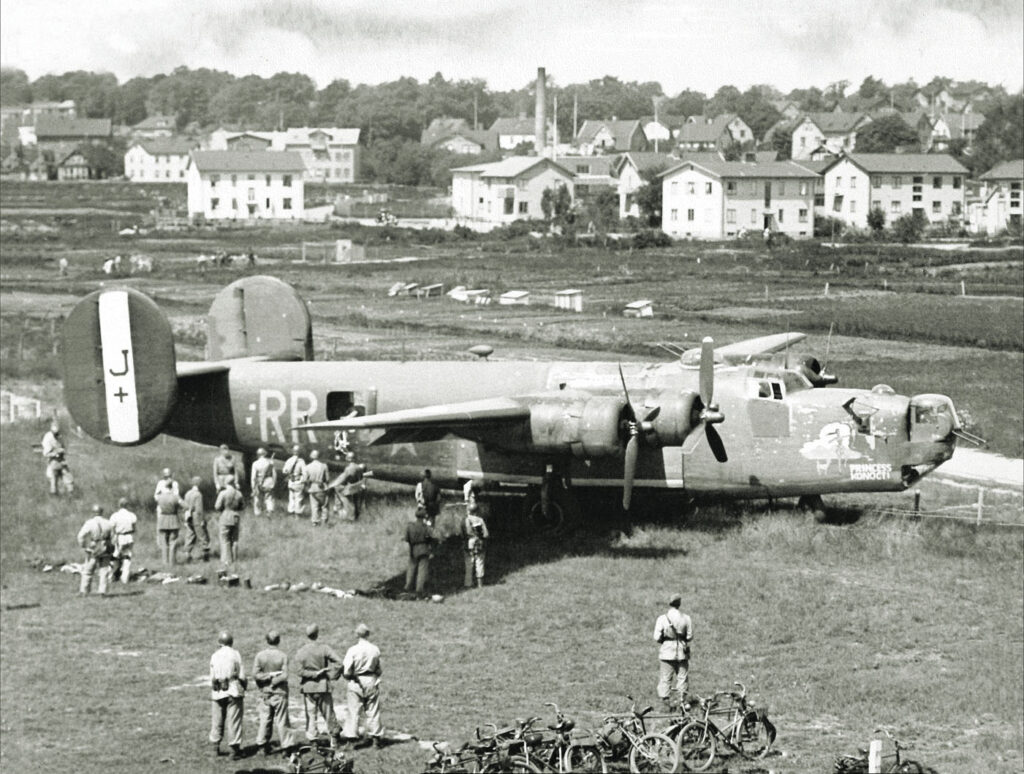
Spaatz blew up over the implication that the crews were cowards or lacked the will to fight. “Such is a base slander against the most courageous group of fighting men in this war,” he wrote back, adding that the number of interned airmen amounted to only a small fraction of the crews dispatched.
Nevertheless, Spaatz followed up on Arnold’s concerns. Maj. Gen. David N.W. Grant, the air surgeon for the USSTAF, wrote to Brig. Gen. Malcolm C. Grow, director of medical services at USSTAF headquarters in Washington, D.C., saying that Arnold believed—“and I agree with him”—that the “best survey” of crew morale should be carried out by flight surgeons. One flight surgeon who was selected for the task was Major John D. Young Jr., who had been a passenger on the Liberator Mistah Chick that had made a forced landing in Sweden on June 20. As a “non-combatant,” he was not interned with the crew but was attached to the American Legation in Stockholm to provide medical care to Americans. While in Sweden Young interviewed about 500 internees and concluded that the general feeling among them was one of “great thankfulness” to have survived and that they would “not like to repeat this experience.” But after a week or two, the more harrowing aspects of the experience tended to fade, Young said, and the men would begin to feel restless and want “to get back to flying again.”
There were five main internment camps in Sweden—Falun, Rättvik, Loka Brunn, Gränna and Mullsjö—and Young visited all of them. He said that the internees were free to leave the camps and mix with Swedish civilians and that the men were able to “freely date” Swedish women. “I think it has been remarkable that they have gotten on as well as they have,” Young said.
Queried by an Air Forces intelligence officer, Lt. Col. R.E. Stone, Young said that the internees had not force-landed in Sweden to evade further military service. “There are aircraft reports to substantiate that their planes were badly damaged and that it was foolhardy to attempt to return [to England],” Young said, adding that, beyond any doubt, they had used their “good judgment” in deciding to head for Sweden.
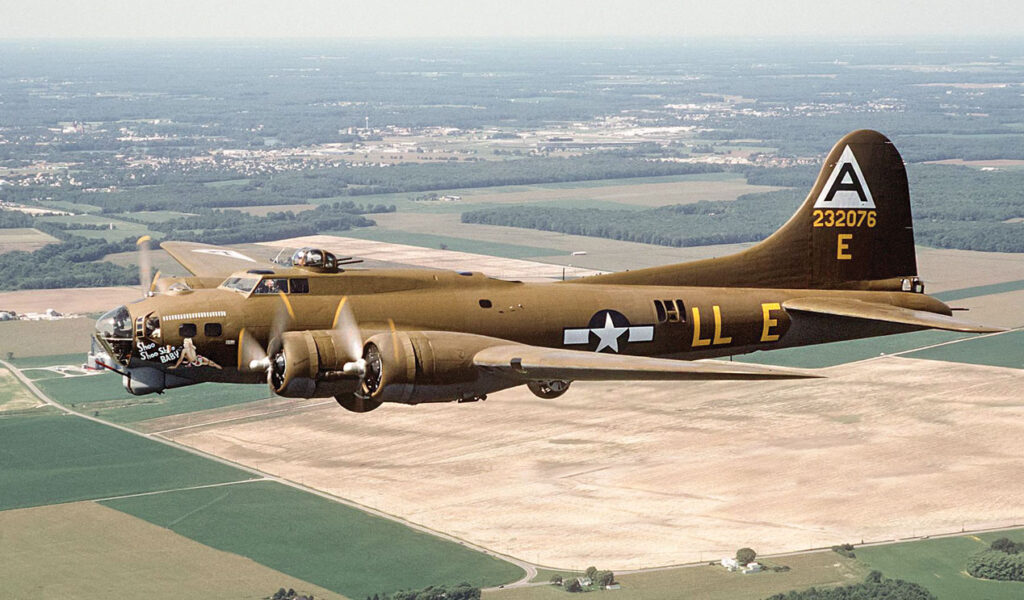
In addition, the USSTAF’s Office of the Surgeon sent out a questionnaire to every squadron surgeon serving in the Eighth Air Force at the time, and representatives of the office made personal visits to units that were suspected of having low morale or whose personnel had made force-landings in Sweden.
At the end of the process, Grow concluded that five crews “may” have landed in Sweden “for the purpose of avoiding further combat.” But his report emphasized that the number of crews that had done so was “so low that it is not considered to be of any particular significance.”
As the winds of war began to shift inexorably toward the Allies, the Swedes saw fit to release the internees at a relatively rapid pace—as quickly as they could be flown out of the country. By the end of November 1944, in fact, the number of internees had fallen to about 200—down from a near-high of 1,076 in mid-October. By mid-January 1945, the number was just 25.
Herschel V. Johnson, the American Minister in Stockholm, wrote to Acting Secretary of State Edward R. Stettinius on November 24, 1944, expressing relief and praising the Swedes for the way they had treated the Americans. “The treatment in every respect which the Swedes have accorded our aviators has been humane and understanding to a high degree and beyond the bounds of what are their obligations under international law and custom,” Johnson said.
After their release from internment—sometimes following protracted negotiations between American and Swedish officials over, for example, the sale of North American P-51 Mustangs to the Swedish Air Force—most of the American “bomber boys” were returned to England and further combat. Some released internees were shot down a second time. Arthur Guertin, the navigator on Georgia Rebel, was killed on April 28, 1944, in Georgia Rebel II. Osce V. Jones of Georgia Rebel was also aboard Georgia Rebel II. He survived but spent the rest of the war in a Nazi prison camp.
After the war, Jones continued to serve in the Air Force and flew B-52s and KC-135 tankers as commander of the Strategic Air Command’s 4241st Strategic Wing at Seymour Johnson AFB in North Carolina. But Jones never forgot the American airmen who had lost their lives in service to their country in World War II, including the 40-plus men who were killed when their planes force-landed or crashed in neutral Sweden.
